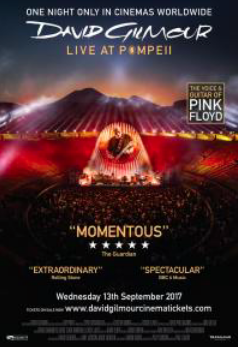
MORGAN HENDERSON
Staff Writer
Last Wednesday night, David Gilmour, former guitarist of Pink Floyd, had his live concert movie played in over 2,000 movie theatres worldwide for one night only. The movie was filmed during his two July 2016 concerts played in the ancient Pompeii ampitheatre.
The movie was shown right here in Fredonia at the Fredonia Opera House.
“I heard about this event through my parents and I’ve seen David Gilmour before in Buffalo. It’s cool that we can see things like this in Fredonia,” said audience member Sean Wysong.
There is a diverse range in shows made available at the Fredonia Opera house.
“These shows are made possible through a satellite network. We’ve had showings from all over the world, such as the Metropolitan theatre in New York City, the National Theatre in London and theatres in Moscow,” said Rick Davis, executive director of the Fredonia Opera House.
The Opera House decided to bring “David Gilmour Live at Pompeii” to Fredonia because a couple years prior they had “Roger Waters: The Wall” shown and it was “well received,” said Davis. Roger Waters is the former singer of Pink Floyd, and the movie was of similar format.
The movie started off with David Gilmour saying, “Performing live is the lifeblood of music.” This was evident through his performances. The music was truly moving and nothing like you could hear on his recorded tracks.
You could tell the energy was high during those two nights by the looks on the accompanying musicians’ faces. They all had smiles from ear to ear. The crowd played into it as they finished some of the lyrics for David Gilmour.
One of the most interesting attributes of the movie was the setting. The movie included the filming of his two concerts in the ancient Pompeii amphitheatre directly in front of Mt. Vesuvius. The amphitheatre was built in 90 B.C. and it held the ashes from when Mt. Vesuvius erupted in 79 A.D.
David Gilmour was the first ever to have a rock performance in the ancient Roman amphitheatre. He is also the only person to perform for an audience in the arena since gladiator times 2,000 years ago.
“I can’t imagine what an experience it must have been for David Gilmour,” said Davis.
The historical site made the concert that much more unique and aesthetically pleasing.
“We’ll be playing with the ghosts of recent past and distant,” said Gilmour.
I’m sure he encountered some ghosts through playing his old music, as well as the feeling of the past while playing in such a historic venue.
Another great aspect of the film was the visual element. The huge circular cyclorama screen was the centerpiece of the stage. There was never a moment where it wasn’t lit up with art.
“The visuals were really fascinating,”said Davis.
The film started with black and white cartoons on the screen, and then it changed to surreal videos. There was film of them in the arena during the day, so the audience had a chance to see it in a different light. They also had props on stage that were used in the film playing in the background. For example, there was a huge bell that the drummer was banging on during the show and then there was a short slide of him carrying it on his back on the screen.
“The best part were some of the visuals,” said Jay Glascott, senior psychology major and audience member.
There were camera shots from overhead revealing the enormous crowd. There were even shots of people in the crowd videotaping the performance with their phones.
“It was cool to see how they were seeing it while they were there,” said Glascott.
Overall, the film was a huge success of musical and visual talent. But perhaps the real miracle was the technology making this once-in-a-lifetime performance available to people all around the world.
